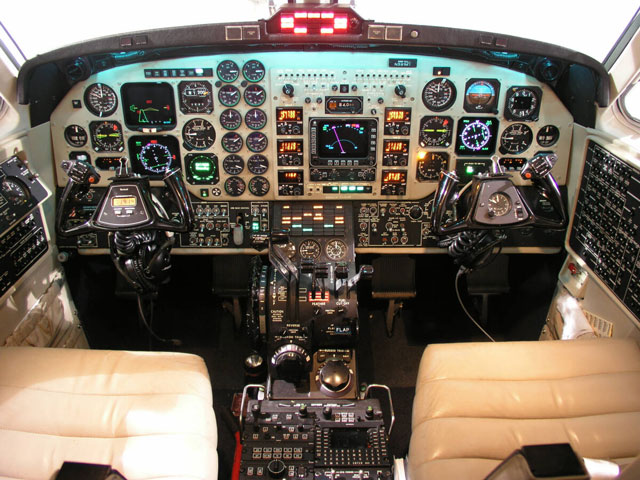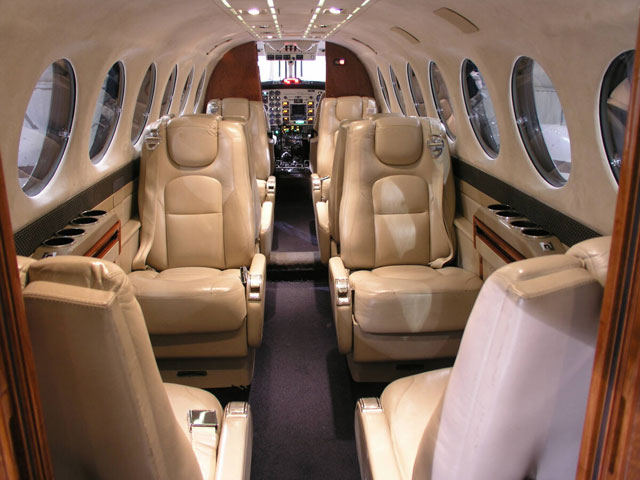


Aircraft Description
Background/History
The first Beechcraft 65-90 took to the air in January 1964. Based on the Model 65 Queen Air, the -90 featured the then-new Pratt & Whitney Canada PT6A turboprop engines in place of the Lycoming flat-six piston engines. A pressurized model was designated the King Air 90. Many variants followed including the stretched King Air 100 and the further-stretched Super King Air 200 and 300 models which utilized more powerful versions of the PT6A. At the 1989 NBAA convention, Beech introduced the Super King Air 350. This still-larger member of the Super King Air line is 46.7 ft. in length, two feet longer than the 300 and eleven feet longer than the C90 with a wingspan of nearly 58 feet. The Super King Air 350 received FAA certification in February 1990 under FAR Part 23 as a commuter category aircraft, greater than 12,500lbs gross weight and requires two pilots. The King Air 350 remains a current offering from Hawker Beechcraft with over 500 produced and delivered through 2007. A new extended range variant, the King Air 350ER entered service in 2007. The 350ER has additional nacelle fuel tanks, heavy-weight landing gear and a maximum take-off weight increased to 16,500lbs. This gives the aircraft an extended IFR range of 2,147nm and eight-hour endurance. The 350ER was developed as a special mission aircraft for aerial surveillance, but is also available in an executive travel configuration.
Power
The King Air 350ER is powered by two Pratt & Whitney Canada PT6A-60A turboprop engines rated at 1,050shp at ISA +10C, each driving a Hartzell four-bladed, full-feathering, reversible, and constant speed propeller. Engine inspection interval is 3,600 hours.
Avionics
The King Air 350ER is equipped with the Rockwell Collins Pro Line 21 avionics suite as standard equipment. This includes 8in x 10in primary flight displays based on active matrix LCD (liquid crystal display) technology and a multi-function display with primary engine information, systems synoptics, checklists and navigational data including planning maps, present-position maps and heading. Terrain, traffic, lightning, weather radar and other sensor information can also be displayed. Pro Line 21 includes: the FMS-3000 flight management system (Dual FMS is optional), dual flight directors, fail-passive autopilot, Global Positioning System (GPS), dual solid-state Attitude Heading Reference System (AHRS), dual digital air data computers and turbulence detection radar. A Rockwell Collins Remote Radio Tuning Unit (RTU) provides centralized control of the Pro Line 21 radio tuning.
Design Features
The King Air 350ER is a pressurized, twin-engine turboprop business aircraft configured as a cantilever low-wing monoplane with a T-tail and aft ventral fin. It has retractable tricycle landing gear with dual wheels on each main unit. The 350 series incorporates a 34- inch stretch of the King Air 300 fuselage and has one additional window per side. The wingspan has been increased by 3 feet over that of the model 300, and 24-inch graphite composite winglets have been added to the wingtips to reduce drag at higher angles of attack as in takeoff and climb out. The Super King Air 350 benefits from recent improvements throughout the King Air line including reduced cabin noise levels, a three-bus electrical system, and a “ground fine” range of propeller control to minimize the need for brake use during taxi. The aircraft’s bladder cells and integral fuel tanks in each wing provide a usable fuel capacity of 3,611lbs. Auxiliary fuel tanks located inboard of the engine nacelles bring the total usable fuel capacity to 5192 lbs.
Accomodations
The cabin of the King Air 350ER has seating for eight passengers in a double club arrangement. The aft lavatory also has a belted seat. The seats are fully adjustable and reclining, and track in and out from the wall. Folding work tables, cup holders, and individual fresh air inlets are included. A large stand-up, 55.3 cubic foot, baggage area is located at the aft end of the cabin. Total passenger cabin volume including lav and baggage area is 355 cubic feet.
| General | King Air 350ER, B300ER | |||
|---|---|---|---|---|
| Category | Multiengine Turboprop > 12,500 lbs. | |||
| Years Aircraft Manufactured | 2007 – current | |||
| Serial Number Range | FL1-546 -687 | |||
| Retail High Price | $7,370,000.00 / 5,783,239.00€ | |||
| Retail Low Price | $5,950,000.00 / 4,668,965.00€ | |||
| Characteristics | King Air 350ER, B300ER | |||
| Seating | 1+9/11 | |||
| Wing Loading | 53.2 | |||
| Power Loading | 7.9 | |||
| Noise(EPNdB): Takeoff/Sideline/Approach | 81.5 | |||
| External Dimensions (ft) | King Air 350ER, B300ER | |||
| External Length | 46.7 | |||
| External Height | 14.3 | |||
| External Span | 57.9 | |||
| Internal Dimensions (ft) | King Air 350ER, B300ER | |||
| Internal Length (Overall/Net Height) | 19.5/19.5 | |||
| Internal Height | 4.8 | |||
| Internal Width (Max/Floor) | 4.5/4.1 | |||
| Baggage | King Air 350ER, B300ER | |||
| External: Cu.Ft./Lb. | 55.3/550 | |||
| External: Cu.Ft./Lb. | N/A | |||
| Power | King Air 350ER, B300ER | |||
| Engines | 2 P&WC PT6A-60A | |||
| Output (lbs ea.)/Flat Rating | 1,050shp | |||
| Inspection Interval | 3,600t | |||
| Data based on latest manufactured year | ||||



